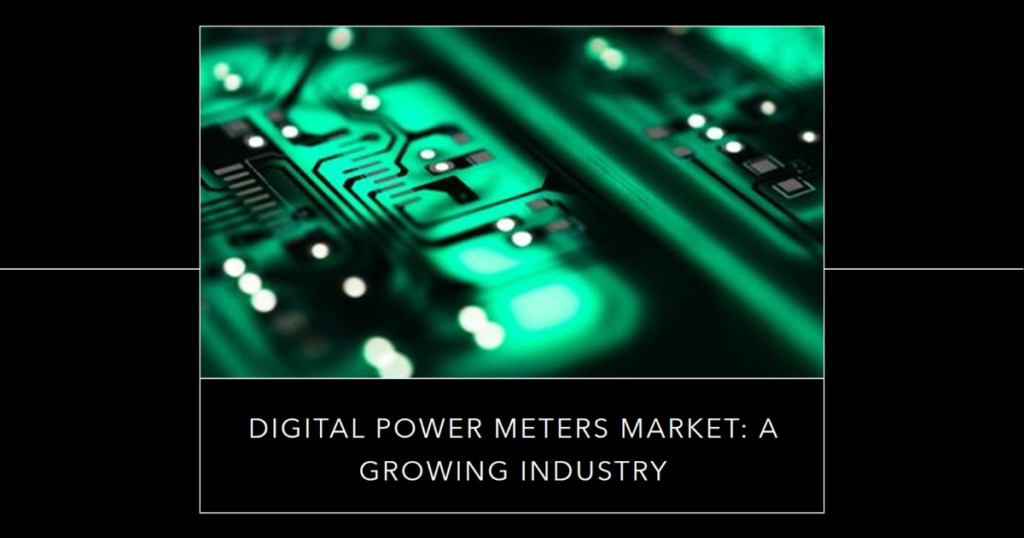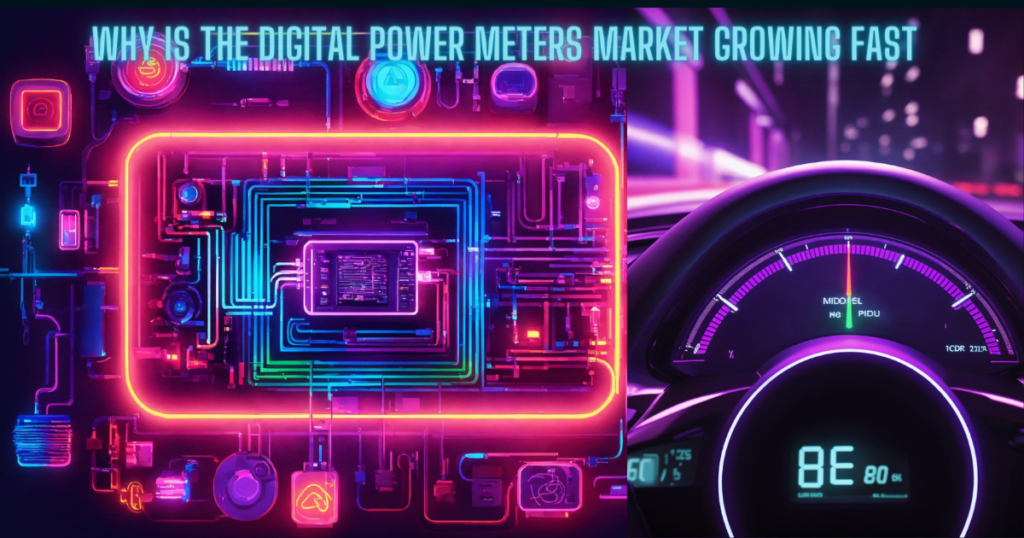Introduction:
Digital power meters represent a significant leap forward in the measurement and management of electricity consumption, offering heightened accuracy, reliability, and efficiency compared to their analog counterparts. These advanced devices cater to a wide spectrum of users, ranging from households to industrial facilities. Beyond basic metering, digital power meters provide real-time insights into energy usage, power quality, and power factor, enabling users to make informed decisions for optimal consumption and cost reduction. Moreover, their integration with smart grid systems aligns with global initiatives to embrace renewable energy and enhance overall energy efficiency.

15 Key Points on Digital Power Meters:
- 1. Introduction to Digital Power Meters:
- 2. Real-time Data and Optimization:
- 3. Integration with Smart Grid Systems:
- 4. Global Market Growth Projection:
- 5. Key Market Drivers of Digital Power Meters:
- 6. Smart Grid Technology Impact:
- 7. Awareness and Demand for Energy Efficiency:
- 8. Government Initiatives and Regulations:
- 9. Market Segmentation Overview:
- 10. Competitive Landscape: Digital Power Meters
- 11. Challenges in the Market of Digital Power Meters
- 12. Opportunities for Growth of Digital Power Meters
- 13. Role in Smart Homes and Buildings:
- 14. Integration of IoT and AI:
- 15. Focus on Renewable Energy:
- Conclusion: Digital Power Meters
- People also Ask
- Disclaimer
1. Introduction to Digital Power Meters:
Digital power meters are devices designed to measure and display electricity consumption in households, businesses, and industrial facilities. Unlike traditional analog meters, digital power meters offer enhanced accuracy, reliability, and efficiency, as they do not rely on mechanical components prone to wear and malfunction.
2. Real-time Data and Optimization:
These meters provide real-time data on energy usage, power quality, and power factor, enabling users to optimize consumption and reduce electricity costs. Additionally, digital power meters can interface with smart grid systems, facilitating the integration of renewable energy sources, demand response, and load management.
3. Integration with Smart Grid Systems:
The adoption of smart grid technology significantly propels the digital power meters market. Smart grids enhance power distribution system reliability, security, and efficiency through digital communication and automation. Digital power meters are integral to smart grid systems, providing two-way communication and real-time data on energy consumption.
4. Global Market Growth Projection:
The global digital power meters market anticipates a 7.2% compound annual growth rate (CAGR) from 2023 to 2033, reaching a value of US$20 billion by 2033. Factors driving this growth include increased adoption of smart grid technology, heightened awareness about energy efficiency benefits, and supportive government initiatives promoting digital power meter adoption.
5. Key Market Drivers of Digital Power Meters:
Growing awareness of energy efficiency fuels demand for digital power meters. These meters empower users to reduce energy consumption without compromising service or output quality. Users receive detailed information on energy usage patterns, enabling adjustments for greater efficiency and cost savings.

6. Smart Grid Technology Impact:
The adoption of smart grid technology is a key driver, aiming to improve reliability, security, and efficiency in power distribution systems. Digital power meters play an essential role by providing real-time data on energy consumption and power quality.
7. Awareness and Demand for Energy Efficiency:
Rising awareness about the benefits of energy efficiency is another significant factor driving the demand for digital power meters. Users can achieve energy efficiency by receiving detailed information on their energy usage patterns and adjusting their consumption accordingly.
8. Government Initiatives and Regulations:
Government initiatives further drive market growth. Globally, policies and regulations encourage digital power meter installation to improve energy efficiency, reduce carbon footprints, and support smart grid infrastructure development. Examples include the European Union’s mandate for 80% smart meter adoption by 2020. And India’s Smart Meter National Programme aiming to replace 250 million conventional meters by 2024.
9. Market Segmentation Overview:
Market segmentation includes basis phase (single and three-phase), product type (digital, electrical, electromechanical, electronic), technology (radio frequency, power line communication, cellular), and application (residential, commercial, industrial). Asia-Pacific leads the market due to rapid urbanization, industrialization, and government support.
10. Competitive Landscape: Digital Power Meters
The market is highly competitive and fragmented, with key players such as Schneider Electric, Siemens, Honeywell, Itron, Landis+Gyr, ABB, General Electric, Eaton, Kamstrup, and Sensus. These companies compete based on product innovation, quality, price, features, and customer service.
11. Challenges in the Market of Digital Power Meters
Challenges for the digital power meters market include high initial installation costs, lack of interoperability. And standardization, cyberattack risks, data breaches, and consumer privacy concerns.
12. Opportunities for Growth of Digital Power Meters
Opportunities include the growth of the smart homes and buildings market, driven by intelligent devices and systems. And the utilization of advanced technologies like the Internet of Things (IoT) and artificial intelligence (AI). Digital power meters equipped with IoT and AI technologies provide real-time data, automate energy management, and integrate seamlessly with other smart devices, creating connected ecosystems.
13. Role in Smart Homes and Buildings:
Digital power meters play a crucial role in the growth of the smart homes and buildings market, supporting automation and optimization of energy functions.
14. Integration of IoT and AI:
The increasing use of advanced technologies such as IoT and AI enhances the capabilities of digital power meters, providing real-time data and enabling automated energy management.
15. Focus on Renewable Energy:
The growing emphasis on renewable energy presents opportunities for digital power meters, playing a critical role in monitoring and managing renewable energy systems. As the renewable energy market expands, the demand for digital power meters is expected to rise, fostering further growth in the market.
Conclusion: Digital Power Meters
In conclusion, digital power meters have emerged as indispensable tools in modern energy management. And offering unparalleled accuracy, real-time insights, and integration with smart grid systems. The global market is poised for substantial growth, driven by factors such as increasing awareness of energy efficiency, government initiatives, and the adoption of smart grid technology. While facing challenges like high initial costs and cybersecurity risks. The market holds promising opportunities in smart homes, advanced technologies, and the expanding realm of renewable energy. As the world continues its transition towards sustainable energy practices, digital power meters stand at the forefront, facilitating efficient energy consumption and contributing to a greener, more sustainable future.
People also Ask
What is the market of smart meters in India?
As of my last knowledge update in January 2022, the market for smart meters in India has been growing steadily. The Indian government has been actively promoting the adoption of smart meters to enhance efficiency in electricity distribution, reduce losses, and enable better demand management. Various initiatives, such as the Smart Meter National Programme, have been launched to replace conventional meters with smart meters. The market is expected to expand further as utilities and consumers recognize the benefits of real-time data monitoring and control.
What causes electric meters to run fast?
Electric meters may run fast due to several reasons, including mechanical issues, wear and tear, or calibration problems. Factors such as voltage fluctuations, overloading, or incorrect meter sizing can impact accuracy. It’s essential to address these issues promptly to ensure accurate billing and prevent financial discrepancies. Inaccurate readings may also result from meter tampering or faults in the metering equipment. If you suspect your electric meter is running fast, it’s advisable to contact your utility provider to inspect and rectify the problem.
What is a digital power meter?
A digital power meter is an advanced device designed to measure and display the amount of electricity consumed by a household, business, or industrial facility. Unlike traditional analog meters, digital power meters utilize digital technology to provide more accurate and reliable readings. They often offer features such as real-time data on energy usage, power quality, and power factor. Digital power meters play a crucial role in modern energy management, allowing users to optimize their energy consumption, reduce costs, and integrate with smart grid systems for enhanced efficiency and sustainability.
Disclaimer
This article has been created on the basis of internal data, information available publicly, and other reliable sources to be believed. The article may also include information which are the personal views/opinions of the authors. The information includes in this article is for general, educational, and awareness purposes only and is not a full disclosure of every material fact.
All the information on this website i.e. World Virtual CFO – is published in good faith and for general information purposes only. World Virtual CFO does not make any warranties about the completeness, reliability, and accuracy of this information. These are my views for only information purposes. Any action you take upon the information you find on this website (World Virtual CFO), is strictly at your own risk. World Virtual CFO will not be liable for any losses and/or damages in connection with using our website. For details please refer to our disclaimer page.
Dr. Dinesh Sharma is an award-winning CFO and AI strategist with over two decades of experience in financial leadership, digital transformation, and business optimization. As the founder of multiple niche platforms—including WorldVirtualCFO.com—he empowers professionals and organizations with strategic insights, system structuring, and innovative tools for sustainable growth. His blogs and e-books blend precision with vision, making complex financial and technological concepts accessible and actionable.